MAN508 Organisational Strategy and Leadership: Healthcare Industry
VerifiedAdded on 2023/06/12
|17
|4659
|260
Report
AI Summary
This report provides a detailed analysis of organizational strategy and leadership within the healthcare industry. It begins by evaluating the external environment using PESTLE and Porter's Five Forces analyses, identifying key political, economic, social, technological, legal, and environmental factors, as well as competitive forces. The report then examines organizational culture and its impact on service delivery, followed by a discussion of business strategies specific to the healthcare industry. The formal organizational structure is analyzed in terms of its impact on communication and decision-making processes. Finally, the report explores appropriate leadership theories relevant to the healthcare context, providing a comprehensive overview of strategic management and leadership principles within the sector. Desklib is your go-to resource for similar solved assignments and past papers.
Contribute Materials
Your contribution can guide someone’s learning journey. Share your
documents today.
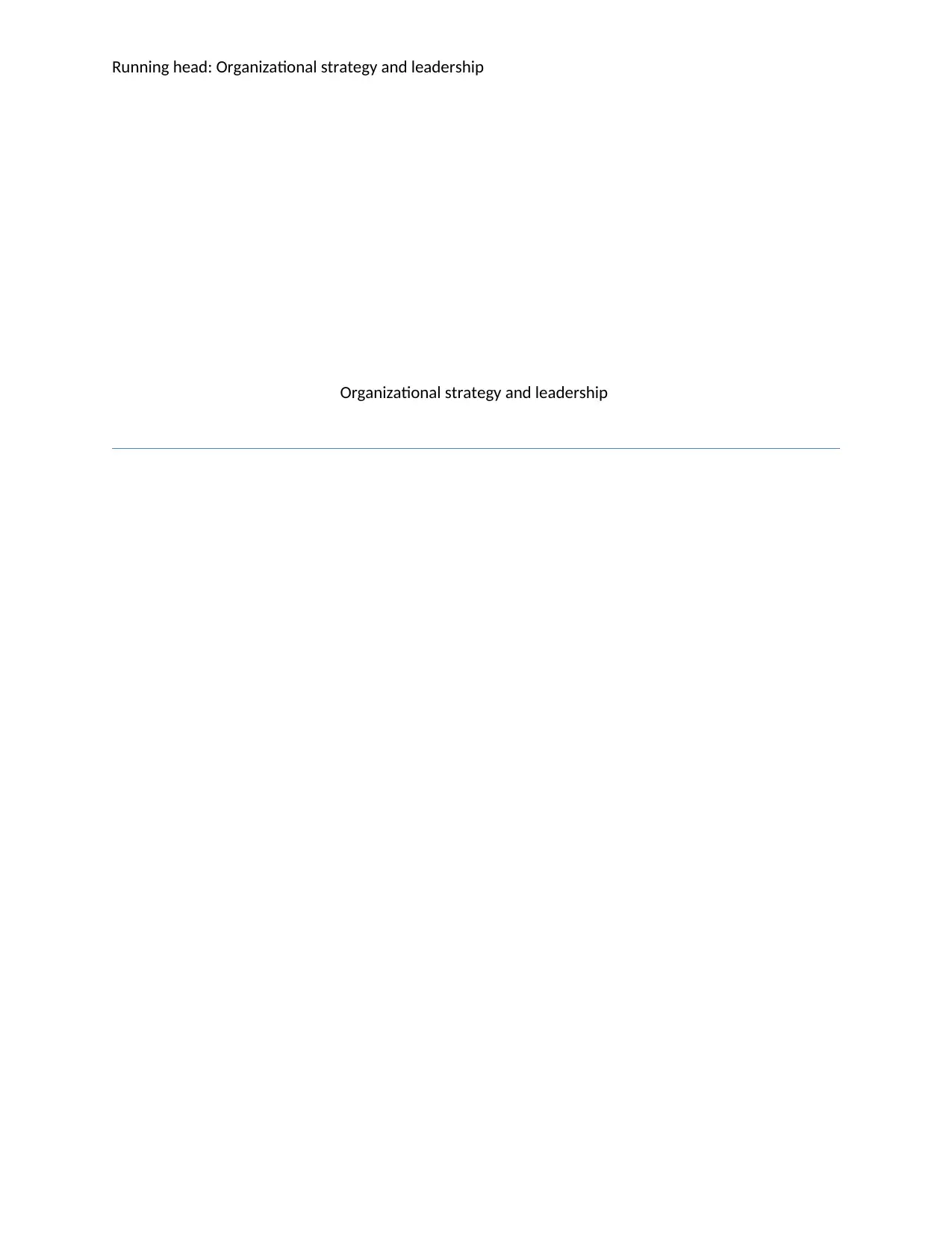
Running head: Organizational strategy and leadership
Organizational strategy and leadership
Organizational strategy and leadership
Secure Best Marks with AI Grader
Need help grading? Try our AI Grader for instant feedback on your assignments.
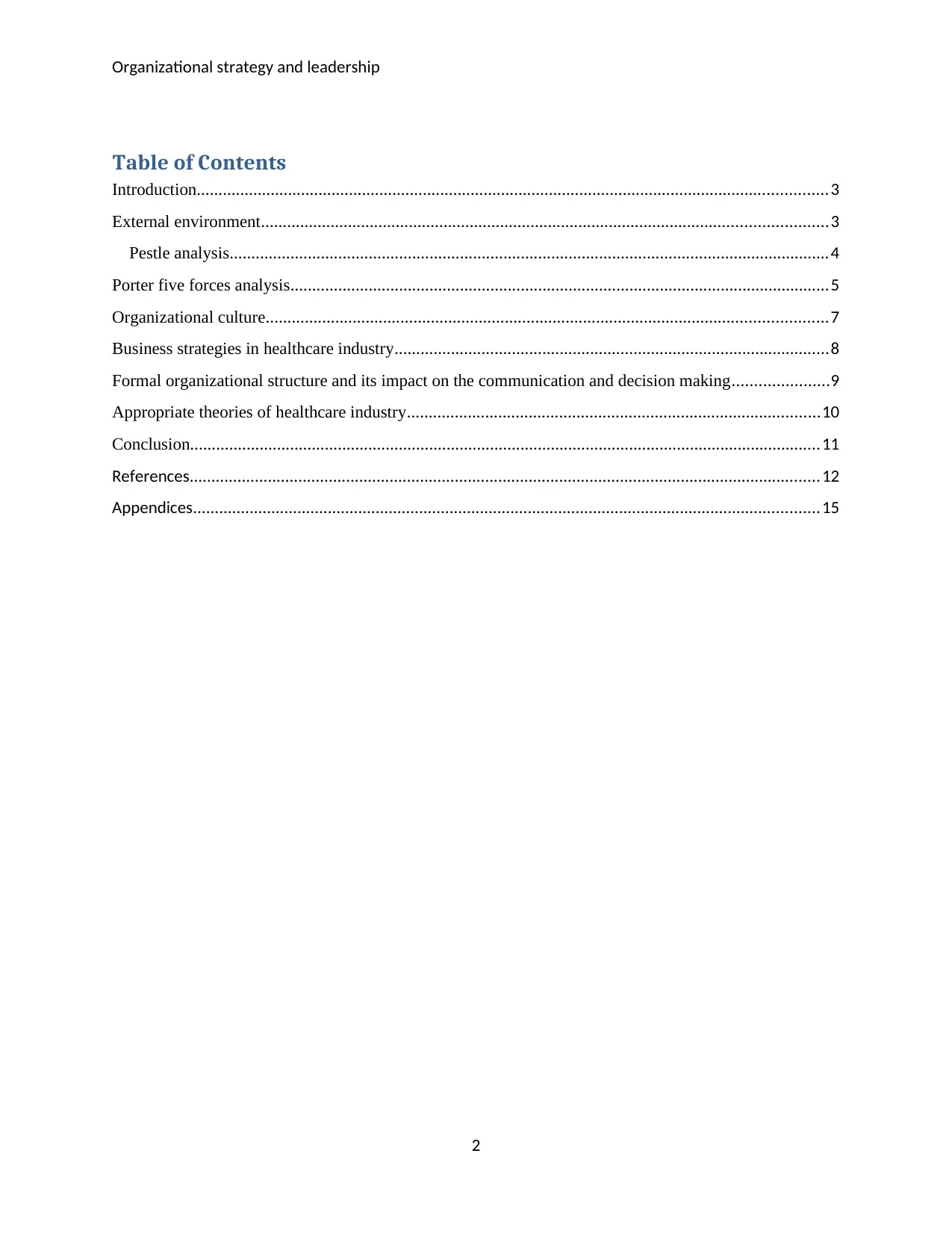
Organizational strategy and leadership
Table of Contents
Introduction.................................................................................................................................................3
External environment..................................................................................................................................3
Pestle analysis..........................................................................................................................................4
Porter five forces analysis............................................................................................................................5
Organizational culture.................................................................................................................................7
Business strategies in healthcare industry....................................................................................................8
Formal organizational structure and its impact on the communication and decision making......................9
Appropriate theories of healthcare industry...............................................................................................10
Conclusion.................................................................................................................................................11
References.................................................................................................................................................12
Appendices................................................................................................................................................15
2
Table of Contents
Introduction.................................................................................................................................................3
External environment..................................................................................................................................3
Pestle analysis..........................................................................................................................................4
Porter five forces analysis............................................................................................................................5
Organizational culture.................................................................................................................................7
Business strategies in healthcare industry....................................................................................................8
Formal organizational structure and its impact on the communication and decision making......................9
Appropriate theories of healthcare industry...............................................................................................10
Conclusion.................................................................................................................................................11
References.................................................................................................................................................12
Appendices................................................................................................................................................15
2
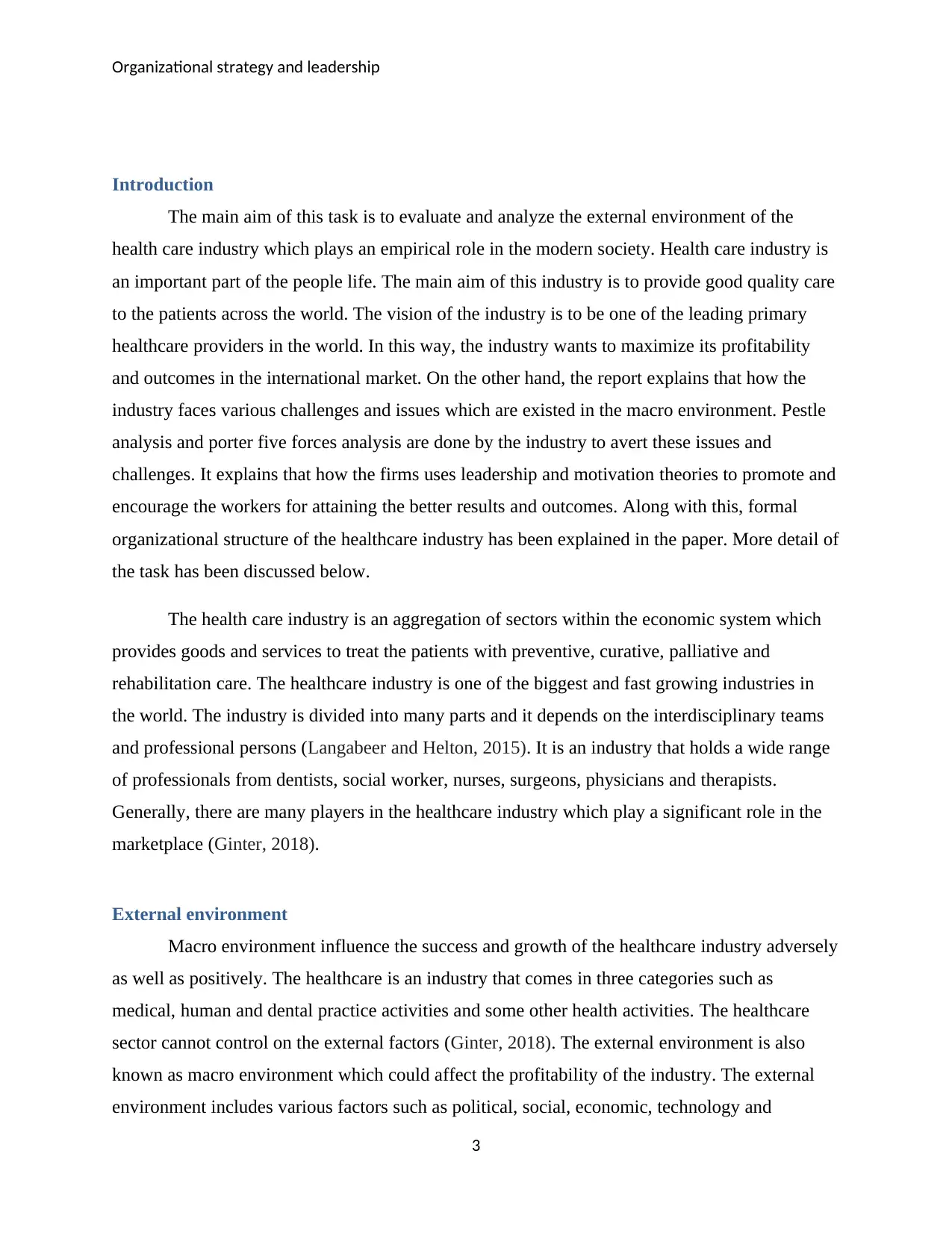
Organizational strategy and leadership
Introduction
The main aim of this task is to evaluate and analyze the external environment of the
health care industry which plays an empirical role in the modern society. Health care industry is
an important part of the people life. The main aim of this industry is to provide good quality care
to the patients across the world. The vision of the industry is to be one of the leading primary
healthcare providers in the world. In this way, the industry wants to maximize its profitability
and outcomes in the international market. On the other hand, the report explains that how the
industry faces various challenges and issues which are existed in the macro environment. Pestle
analysis and porter five forces analysis are done by the industry to avert these issues and
challenges. It explains that how the firms uses leadership and motivation theories to promote and
encourage the workers for attaining the better results and outcomes. Along with this, formal
organizational structure of the healthcare industry has been explained in the paper. More detail of
the task has been discussed below.
The health care industry is an aggregation of sectors within the economic system which
provides goods and services to treat the patients with preventive, curative, palliative and
rehabilitation care. The healthcare industry is one of the biggest and fast growing industries in
the world. The industry is divided into many parts and it depends on the interdisciplinary teams
and professional persons (Langabeer and Helton, 2015). It is an industry that holds a wide range
of professionals from dentists, social worker, nurses, surgeons, physicians and therapists.
Generally, there are many players in the healthcare industry which play a significant role in the
marketplace (Ginter, 2018).
External environment
Macro environment influence the success and growth of the healthcare industry adversely
as well as positively. The healthcare is an industry that comes in three categories such as
medical, human and dental practice activities and some other health activities. The healthcare
sector cannot control on the external factors (Ginter, 2018). The external environment is also
known as macro environment which could affect the profitability of the industry. The external
environment includes various factors such as political, social, economic, technology and
3
Introduction
The main aim of this task is to evaluate and analyze the external environment of the
health care industry which plays an empirical role in the modern society. Health care industry is
an important part of the people life. The main aim of this industry is to provide good quality care
to the patients across the world. The vision of the industry is to be one of the leading primary
healthcare providers in the world. In this way, the industry wants to maximize its profitability
and outcomes in the international market. On the other hand, the report explains that how the
industry faces various challenges and issues which are existed in the macro environment. Pestle
analysis and porter five forces analysis are done by the industry to avert these issues and
challenges. It explains that how the firms uses leadership and motivation theories to promote and
encourage the workers for attaining the better results and outcomes. Along with this, formal
organizational structure of the healthcare industry has been explained in the paper. More detail of
the task has been discussed below.
The health care industry is an aggregation of sectors within the economic system which
provides goods and services to treat the patients with preventive, curative, palliative and
rehabilitation care. The healthcare industry is one of the biggest and fast growing industries in
the world. The industry is divided into many parts and it depends on the interdisciplinary teams
and professional persons (Langabeer and Helton, 2015). It is an industry that holds a wide range
of professionals from dentists, social worker, nurses, surgeons, physicians and therapists.
Generally, there are many players in the healthcare industry which play a significant role in the
marketplace (Ginter, 2018).
External environment
Macro environment influence the success and growth of the healthcare industry adversely
as well as positively. The healthcare is an industry that comes in three categories such as
medical, human and dental practice activities and some other health activities. The healthcare
sector cannot control on the external factors (Ginter, 2018). The external environment is also
known as macro environment which could affect the profitability of the industry. The external
environment includes various factors such as political, social, economic, technology and
3
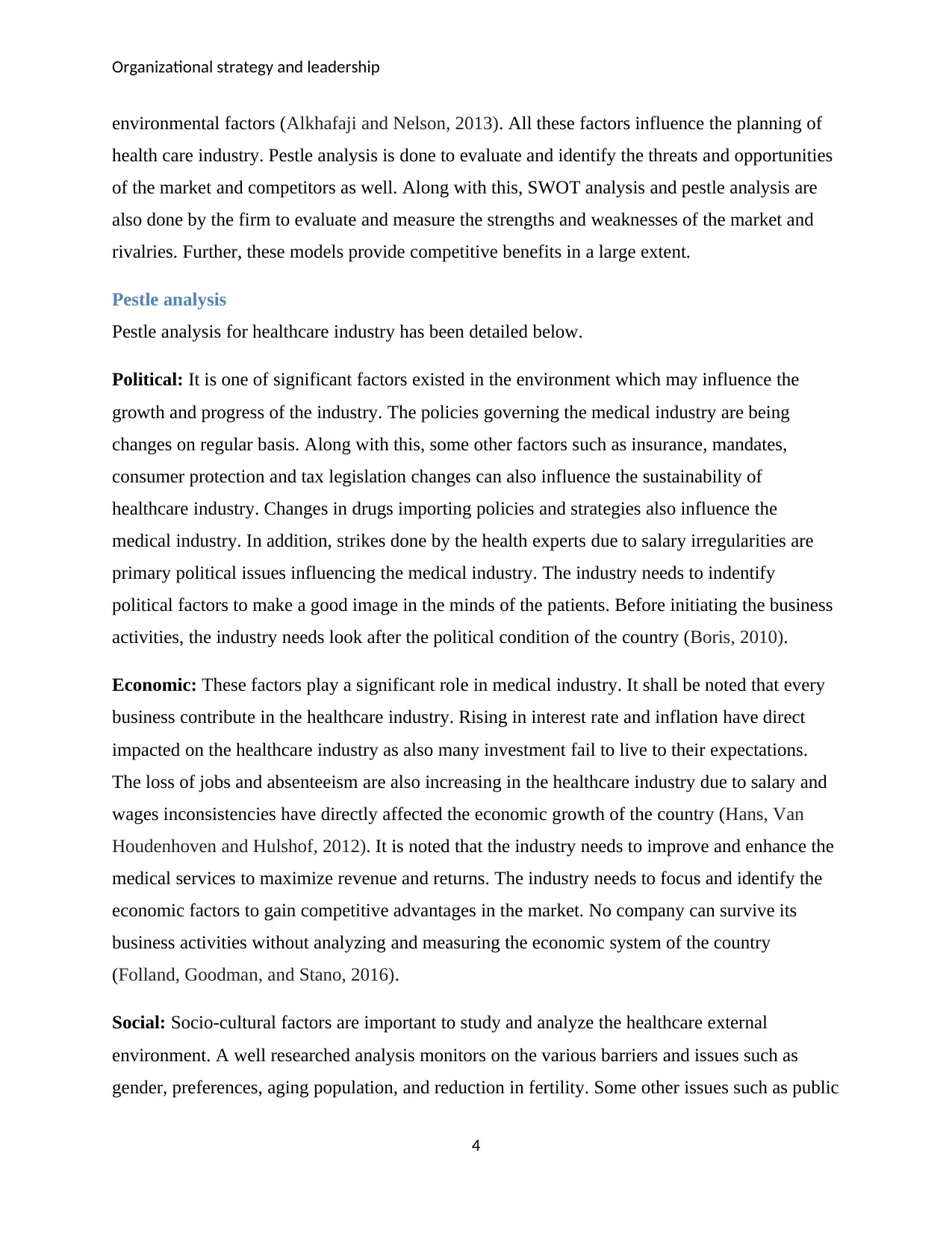
Organizational strategy and leadership
environmental factors (Alkhafaji and Nelson, 2013). All these factors influence the planning of
health care industry. Pestle analysis is done to evaluate and identify the threats and opportunities
of the market and competitors as well. Along with this, SWOT analysis and pestle analysis are
also done by the firm to evaluate and measure the strengths and weaknesses of the market and
rivalries. Further, these models provide competitive benefits in a large extent.
Pestle analysis
Pestle analysis for healthcare industry has been detailed below.
Political: It is one of significant factors existed in the environment which may influence the
growth and progress of the industry. The policies governing the medical industry are being
changes on regular basis. Along with this, some other factors such as insurance, mandates,
consumer protection and tax legislation changes can also influence the sustainability of
healthcare industry. Changes in drugs importing policies and strategies also influence the
medical industry. In addition, strikes done by the health experts due to salary irregularities are
primary political issues influencing the medical industry. The industry needs to indentify
political factors to make a good image in the minds of the patients. Before initiating the business
activities, the industry needs look after the political condition of the country (Boris, 2010).
Economic: These factors play a significant role in medical industry. It shall be noted that every
business contribute in the healthcare industry. Rising in interest rate and inflation have direct
impacted on the healthcare industry as also many investment fail to live to their expectations.
The loss of jobs and absenteeism are also increasing in the healthcare industry due to salary and
wages inconsistencies have directly affected the economic growth of the country (Hans, Van
Houdenhoven and Hulshof, 2012). It is noted that the industry needs to improve and enhance the
medical services to maximize revenue and returns. The industry needs to focus and identify the
economic factors to gain competitive advantages in the market. No company can survive its
business activities without analyzing and measuring the economic system of the country
(Folland, Goodman, and Stano, 2016).
Social: Socio-cultural factors are important to study and analyze the healthcare external
environment. A well researched analysis monitors on the various barriers and issues such as
gender, preferences, aging population, and reduction in fertility. Some other issues such as public
4
environmental factors (Alkhafaji and Nelson, 2013). All these factors influence the planning of
health care industry. Pestle analysis is done to evaluate and identify the threats and opportunities
of the market and competitors as well. Along with this, SWOT analysis and pestle analysis are
also done by the firm to evaluate and measure the strengths and weaknesses of the market and
rivalries. Further, these models provide competitive benefits in a large extent.
Pestle analysis
Pestle analysis for healthcare industry has been detailed below.
Political: It is one of significant factors existed in the environment which may influence the
growth and progress of the industry. The policies governing the medical industry are being
changes on regular basis. Along with this, some other factors such as insurance, mandates,
consumer protection and tax legislation changes can also influence the sustainability of
healthcare industry. Changes in drugs importing policies and strategies also influence the
medical industry. In addition, strikes done by the health experts due to salary irregularities are
primary political issues influencing the medical industry. The industry needs to indentify
political factors to make a good image in the minds of the patients. Before initiating the business
activities, the industry needs look after the political condition of the country (Boris, 2010).
Economic: These factors play a significant role in medical industry. It shall be noted that every
business contribute in the healthcare industry. Rising in interest rate and inflation have direct
impacted on the healthcare industry as also many investment fail to live to their expectations.
The loss of jobs and absenteeism are also increasing in the healthcare industry due to salary and
wages inconsistencies have directly affected the economic growth of the country (Hans, Van
Houdenhoven and Hulshof, 2012). It is noted that the industry needs to improve and enhance the
medical services to maximize revenue and returns. The industry needs to focus and identify the
economic factors to gain competitive advantages in the market. No company can survive its
business activities without analyzing and measuring the economic system of the country
(Folland, Goodman, and Stano, 2016).
Social: Socio-cultural factors are important to study and analyze the healthcare external
environment. A well researched analysis monitors on the various barriers and issues such as
gender, preferences, aging population, and reduction in fertility. Some other issues such as public
4
Secure Best Marks with AI Grader
Need help grading? Try our AI Grader for instant feedback on your assignments.
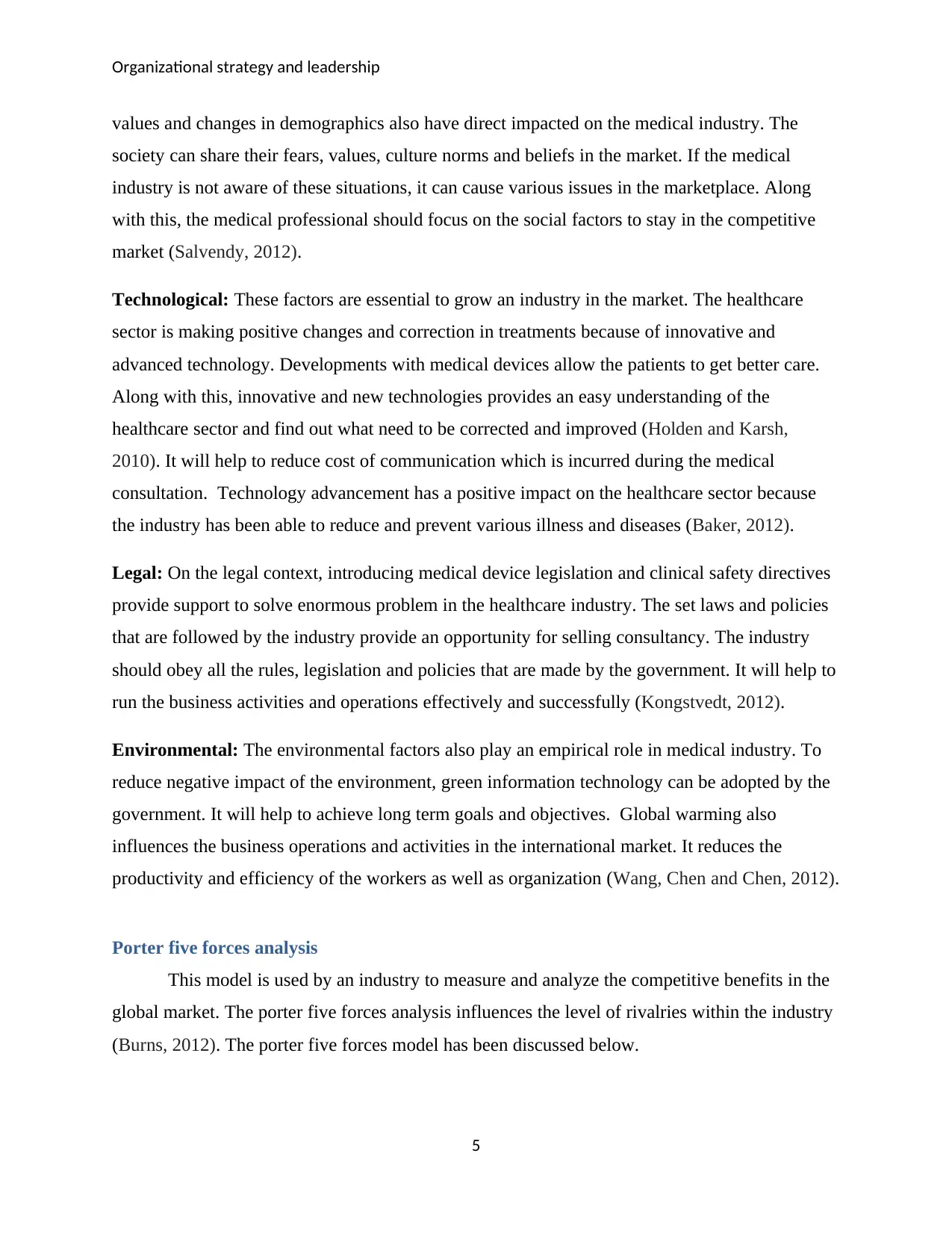
Organizational strategy and leadership
values and changes in demographics also have direct impacted on the medical industry. The
society can share their fears, values, culture norms and beliefs in the market. If the medical
industry is not aware of these situations, it can cause various issues in the marketplace. Along
with this, the medical professional should focus on the social factors to stay in the competitive
market (Salvendy, 2012).
Technological: These factors are essential to grow an industry in the market. The healthcare
sector is making positive changes and correction in treatments because of innovative and
advanced technology. Developments with medical devices allow the patients to get better care.
Along with this, innovative and new technologies provides an easy understanding of the
healthcare sector and find out what need to be corrected and improved (Holden and Karsh,
2010). It will help to reduce cost of communication which is incurred during the medical
consultation. Technology advancement has a positive impact on the healthcare sector because
the industry has been able to reduce and prevent various illness and diseases (Baker, 2012).
Legal: On the legal context, introducing medical device legislation and clinical safety directives
provide support to solve enormous problem in the healthcare industry. The set laws and policies
that are followed by the industry provide an opportunity for selling consultancy. The industry
should obey all the rules, legislation and policies that are made by the government. It will help to
run the business activities and operations effectively and successfully (Kongstvedt, 2012).
Environmental: The environmental factors also play an empirical role in medical industry. To
reduce negative impact of the environment, green information technology can be adopted by the
government. It will help to achieve long term goals and objectives. Global warming also
influences the business operations and activities in the international market. It reduces the
productivity and efficiency of the workers as well as organization (Wang, Chen and Chen, 2012).
Porter five forces analysis
This model is used by an industry to measure and analyze the competitive benefits in the
global market. The porter five forces analysis influences the level of rivalries within the industry
(Burns, 2012). The porter five forces model has been discussed below.
5
values and changes in demographics also have direct impacted on the medical industry. The
society can share their fears, values, culture norms and beliefs in the market. If the medical
industry is not aware of these situations, it can cause various issues in the marketplace. Along
with this, the medical professional should focus on the social factors to stay in the competitive
market (Salvendy, 2012).
Technological: These factors are essential to grow an industry in the market. The healthcare
sector is making positive changes and correction in treatments because of innovative and
advanced technology. Developments with medical devices allow the patients to get better care.
Along with this, innovative and new technologies provides an easy understanding of the
healthcare sector and find out what need to be corrected and improved (Holden and Karsh,
2010). It will help to reduce cost of communication which is incurred during the medical
consultation. Technology advancement has a positive impact on the healthcare sector because
the industry has been able to reduce and prevent various illness and diseases (Baker, 2012).
Legal: On the legal context, introducing medical device legislation and clinical safety directives
provide support to solve enormous problem in the healthcare industry. The set laws and policies
that are followed by the industry provide an opportunity for selling consultancy. The industry
should obey all the rules, legislation and policies that are made by the government. It will help to
run the business activities and operations effectively and successfully (Kongstvedt, 2012).
Environmental: The environmental factors also play an empirical role in medical industry. To
reduce negative impact of the environment, green information technology can be adopted by the
government. It will help to achieve long term goals and objectives. Global warming also
influences the business operations and activities in the international market. It reduces the
productivity and efficiency of the workers as well as organization (Wang, Chen and Chen, 2012).
Porter five forces analysis
This model is used by an industry to measure and analyze the competitive benefits in the
global market. The porter five forces analysis influences the level of rivalries within the industry
(Burns, 2012). The porter five forces model has been discussed below.
5
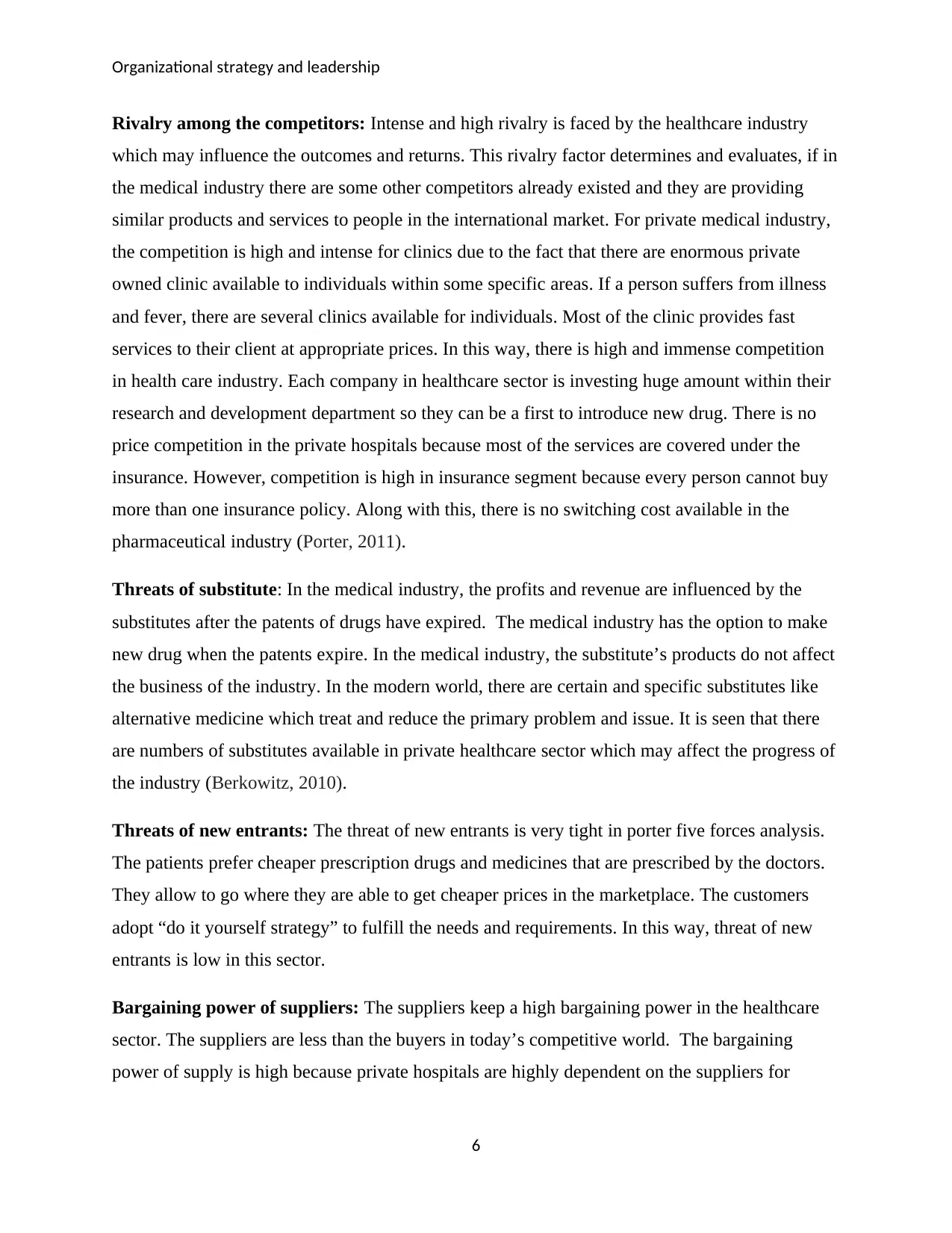
Organizational strategy and leadership
Rivalry among the competitors: Intense and high rivalry is faced by the healthcare industry
which may influence the outcomes and returns. This rivalry factor determines and evaluates, if in
the medical industry there are some other competitors already existed and they are providing
similar products and services to people in the international market. For private medical industry,
the competition is high and intense for clinics due to the fact that there are enormous private
owned clinic available to individuals within some specific areas. If a person suffers from illness
and fever, there are several clinics available for individuals. Most of the clinic provides fast
services to their client at appropriate prices. In this way, there is high and immense competition
in health care industry. Each company in healthcare sector is investing huge amount within their
research and development department so they can be a first to introduce new drug. There is no
price competition in the private hospitals because most of the services are covered under the
insurance. However, competition is high in insurance segment because every person cannot buy
more than one insurance policy. Along with this, there is no switching cost available in the
pharmaceutical industry (Porter, 2011).
Threats of substitute: In the medical industry, the profits and revenue are influenced by the
substitutes after the patents of drugs have expired. The medical industry has the option to make
new drug when the patents expire. In the medical industry, the substitute’s products do not affect
the business of the industry. In the modern world, there are certain and specific substitutes like
alternative medicine which treat and reduce the primary problem and issue. It is seen that there
are numbers of substitutes available in private healthcare sector which may affect the progress of
the industry (Berkowitz, 2010).
Threats of new entrants: The threat of new entrants is very tight in porter five forces analysis.
The patients prefer cheaper prescription drugs and medicines that are prescribed by the doctors.
They allow to go where they are able to get cheaper prices in the marketplace. The customers
adopt “do it yourself strategy” to fulfill the needs and requirements. In this way, threat of new
entrants is low in this sector.
Bargaining power of suppliers: The suppliers keep a high bargaining power in the healthcare
sector. The suppliers are less than the buyers in today’s competitive world. The bargaining
power of supply is high because private hospitals are highly dependent on the suppliers for
6
Rivalry among the competitors: Intense and high rivalry is faced by the healthcare industry
which may influence the outcomes and returns. This rivalry factor determines and evaluates, if in
the medical industry there are some other competitors already existed and they are providing
similar products and services to people in the international market. For private medical industry,
the competition is high and intense for clinics due to the fact that there are enormous private
owned clinic available to individuals within some specific areas. If a person suffers from illness
and fever, there are several clinics available for individuals. Most of the clinic provides fast
services to their client at appropriate prices. In this way, there is high and immense competition
in health care industry. Each company in healthcare sector is investing huge amount within their
research and development department so they can be a first to introduce new drug. There is no
price competition in the private hospitals because most of the services are covered under the
insurance. However, competition is high in insurance segment because every person cannot buy
more than one insurance policy. Along with this, there is no switching cost available in the
pharmaceutical industry (Porter, 2011).
Threats of substitute: In the medical industry, the profits and revenue are influenced by the
substitutes after the patents of drugs have expired. The medical industry has the option to make
new drug when the patents expire. In the medical industry, the substitute’s products do not affect
the business of the industry. In the modern world, there are certain and specific substitutes like
alternative medicine which treat and reduce the primary problem and issue. It is seen that there
are numbers of substitutes available in private healthcare sector which may affect the progress of
the industry (Berkowitz, 2010).
Threats of new entrants: The threat of new entrants is very tight in porter five forces analysis.
The patients prefer cheaper prescription drugs and medicines that are prescribed by the doctors.
They allow to go where they are able to get cheaper prices in the marketplace. The customers
adopt “do it yourself strategy” to fulfill the needs and requirements. In this way, threat of new
entrants is low in this sector.
Bargaining power of suppliers: The suppliers keep a high bargaining power in the healthcare
sector. The suppliers are less than the buyers in today’s competitive world. The bargaining
power of supply is high because private hospitals are highly dependent on the suppliers for
6
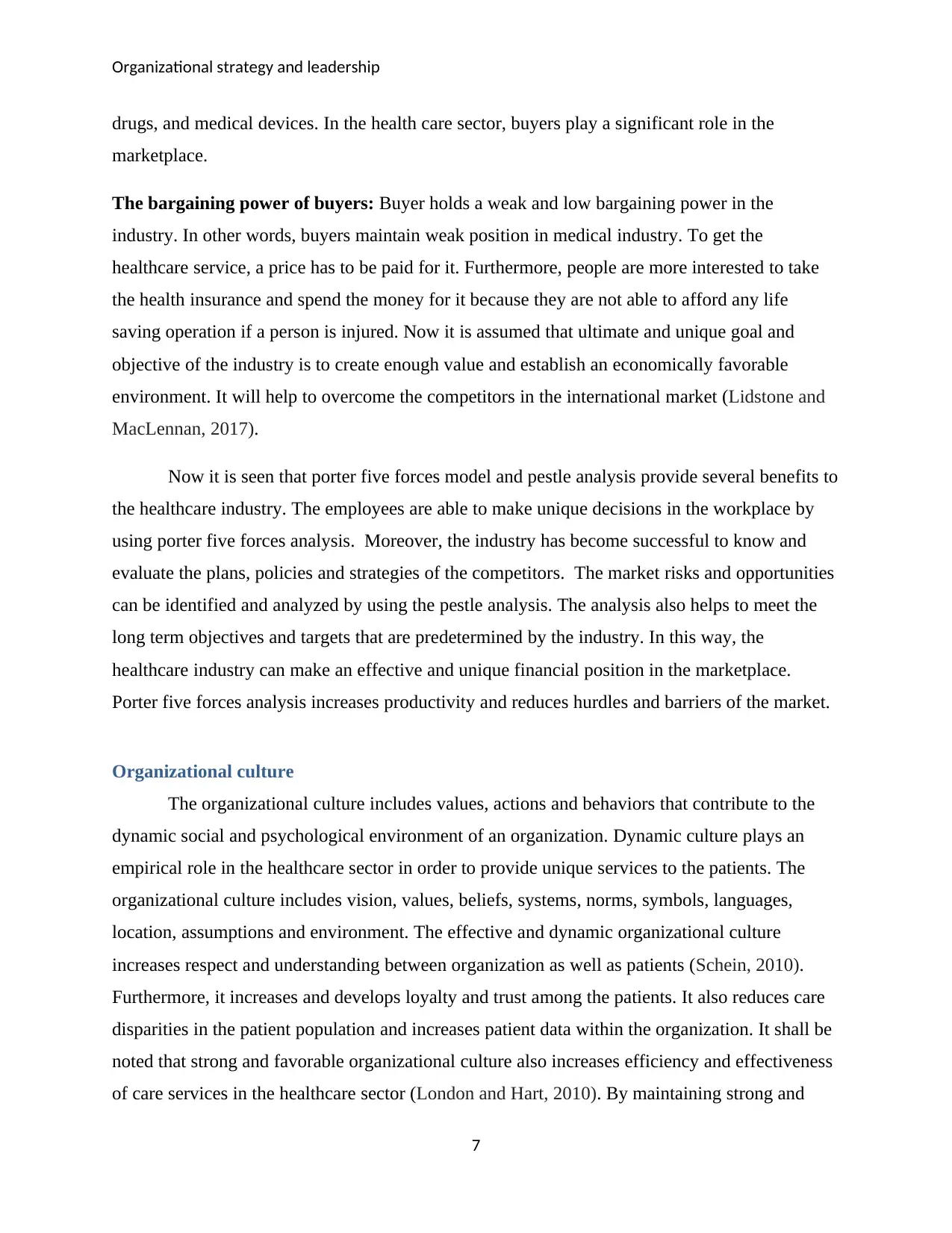
Organizational strategy and leadership
drugs, and medical devices. In the health care sector, buyers play a significant role in the
marketplace.
The bargaining power of buyers: Buyer holds a weak and low bargaining power in the
industry. In other words, buyers maintain weak position in medical industry. To get the
healthcare service, a price has to be paid for it. Furthermore, people are more interested to take
the health insurance and spend the money for it because they are not able to afford any life
saving operation if a person is injured. Now it is assumed that ultimate and unique goal and
objective of the industry is to create enough value and establish an economically favorable
environment. It will help to overcome the competitors in the international market (Lidstone and
MacLennan, 2017).
Now it is seen that porter five forces model and pestle analysis provide several benefits to
the healthcare industry. The employees are able to make unique decisions in the workplace by
using porter five forces analysis. Moreover, the industry has become successful to know and
evaluate the plans, policies and strategies of the competitors. The market risks and opportunities
can be identified and analyzed by using the pestle analysis. The analysis also helps to meet the
long term objectives and targets that are predetermined by the industry. In this way, the
healthcare industry can make an effective and unique financial position in the marketplace.
Porter five forces analysis increases productivity and reduces hurdles and barriers of the market.
Organizational culture
The organizational culture includes values, actions and behaviors that contribute to the
dynamic social and psychological environment of an organization. Dynamic culture plays an
empirical role in the healthcare sector in order to provide unique services to the patients. The
organizational culture includes vision, values, beliefs, systems, norms, symbols, languages,
location, assumptions and environment. The effective and dynamic organizational culture
increases respect and understanding between organization as well as patients (Schein, 2010).
Furthermore, it increases and develops loyalty and trust among the patients. It also reduces care
disparities in the patient population and increases patient data within the organization. It shall be
noted that strong and favorable organizational culture also increases efficiency and effectiveness
of care services in the healthcare sector (London and Hart, 2010). By maintaining strong and
7
drugs, and medical devices. In the health care sector, buyers play a significant role in the
marketplace.
The bargaining power of buyers: Buyer holds a weak and low bargaining power in the
industry. In other words, buyers maintain weak position in medical industry. To get the
healthcare service, a price has to be paid for it. Furthermore, people are more interested to take
the health insurance and spend the money for it because they are not able to afford any life
saving operation if a person is injured. Now it is assumed that ultimate and unique goal and
objective of the industry is to create enough value and establish an economically favorable
environment. It will help to overcome the competitors in the international market (Lidstone and
MacLennan, 2017).
Now it is seen that porter five forces model and pestle analysis provide several benefits to
the healthcare industry. The employees are able to make unique decisions in the workplace by
using porter five forces analysis. Moreover, the industry has become successful to know and
evaluate the plans, policies and strategies of the competitors. The market risks and opportunities
can be identified and analyzed by using the pestle analysis. The analysis also helps to meet the
long term objectives and targets that are predetermined by the industry. In this way, the
healthcare industry can make an effective and unique financial position in the marketplace.
Porter five forces analysis increases productivity and reduces hurdles and barriers of the market.
Organizational culture
The organizational culture includes values, actions and behaviors that contribute to the
dynamic social and psychological environment of an organization. Dynamic culture plays an
empirical role in the healthcare sector in order to provide unique services to the patients. The
organizational culture includes vision, values, beliefs, systems, norms, symbols, languages,
location, assumptions and environment. The effective and dynamic organizational culture
increases respect and understanding between organization as well as patients (Schein, 2010).
Furthermore, it increases and develops loyalty and trust among the patients. It also reduces care
disparities in the patient population and increases patient data within the organization. It shall be
noted that strong and favorable organizational culture also increases efficiency and effectiveness
of care services in the healthcare sector (London and Hart, 2010). By maintaining strong and
7
Paraphrase This Document
Need a fresh take? Get an instant paraphrase of this document with our AI Paraphraser
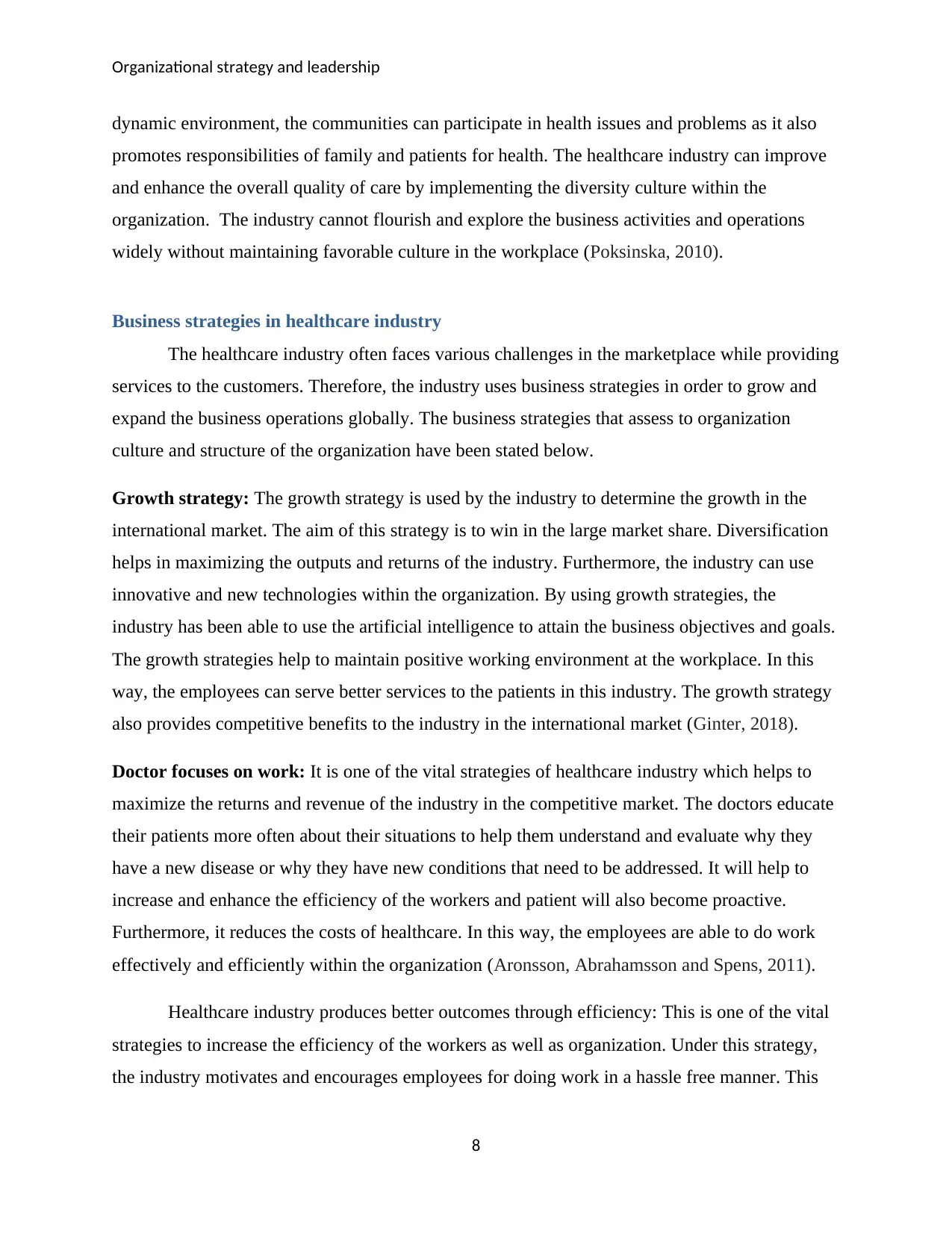
Organizational strategy and leadership
dynamic environment, the communities can participate in health issues and problems as it also
promotes responsibilities of family and patients for health. The healthcare industry can improve
and enhance the overall quality of care by implementing the diversity culture within the
organization. The industry cannot flourish and explore the business activities and operations
widely without maintaining favorable culture in the workplace (Poksinska, 2010).
Business strategies in healthcare industry
The healthcare industry often faces various challenges in the marketplace while providing
services to the customers. Therefore, the industry uses business strategies in order to grow and
expand the business operations globally. The business strategies that assess to organization
culture and structure of the organization have been stated below.
Growth strategy: The growth strategy is used by the industry to determine the growth in the
international market. The aim of this strategy is to win in the large market share. Diversification
helps in maximizing the outputs and returns of the industry. Furthermore, the industry can use
innovative and new technologies within the organization. By using growth strategies, the
industry has been able to use the artificial intelligence to attain the business objectives and goals.
The growth strategies help to maintain positive working environment at the workplace. In this
way, the employees can serve better services to the patients in this industry. The growth strategy
also provides competitive benefits to the industry in the international market (Ginter, 2018).
Doctor focuses on work: It is one of the vital strategies of healthcare industry which helps to
maximize the returns and revenue of the industry in the competitive market. The doctors educate
their patients more often about their situations to help them understand and evaluate why they
have a new disease or why they have new conditions that need to be addressed. It will help to
increase and enhance the efficiency of the workers and patient will also become proactive.
Furthermore, it reduces the costs of healthcare. In this way, the employees are able to do work
effectively and efficiently within the organization (Aronsson, Abrahamsson and Spens, 2011).
Healthcare industry produces better outcomes through efficiency: This is one of the vital
strategies to increase the efficiency of the workers as well as organization. Under this strategy,
the industry motivates and encourages employees for doing work in a hassle free manner. This
8
dynamic environment, the communities can participate in health issues and problems as it also
promotes responsibilities of family and patients for health. The healthcare industry can improve
and enhance the overall quality of care by implementing the diversity culture within the
organization. The industry cannot flourish and explore the business activities and operations
widely without maintaining favorable culture in the workplace (Poksinska, 2010).
Business strategies in healthcare industry
The healthcare industry often faces various challenges in the marketplace while providing
services to the customers. Therefore, the industry uses business strategies in order to grow and
expand the business operations globally. The business strategies that assess to organization
culture and structure of the organization have been stated below.
Growth strategy: The growth strategy is used by the industry to determine the growth in the
international market. The aim of this strategy is to win in the large market share. Diversification
helps in maximizing the outputs and returns of the industry. Furthermore, the industry can use
innovative and new technologies within the organization. By using growth strategies, the
industry has been able to use the artificial intelligence to attain the business objectives and goals.
The growth strategies help to maintain positive working environment at the workplace. In this
way, the employees can serve better services to the patients in this industry. The growth strategy
also provides competitive benefits to the industry in the international market (Ginter, 2018).
Doctor focuses on work: It is one of the vital strategies of healthcare industry which helps to
maximize the returns and revenue of the industry in the competitive market. The doctors educate
their patients more often about their situations to help them understand and evaluate why they
have a new disease or why they have new conditions that need to be addressed. It will help to
increase and enhance the efficiency of the workers and patient will also become proactive.
Furthermore, it reduces the costs of healthcare. In this way, the employees are able to do work
effectively and efficiently within the organization (Aronsson, Abrahamsson and Spens, 2011).
Healthcare industry produces better outcomes through efficiency: This is one of the vital
strategies to increase the efficiency of the workers as well as organization. Under this strategy,
the industry motivates and encourages employees for doing work in a hassle free manner. This
8
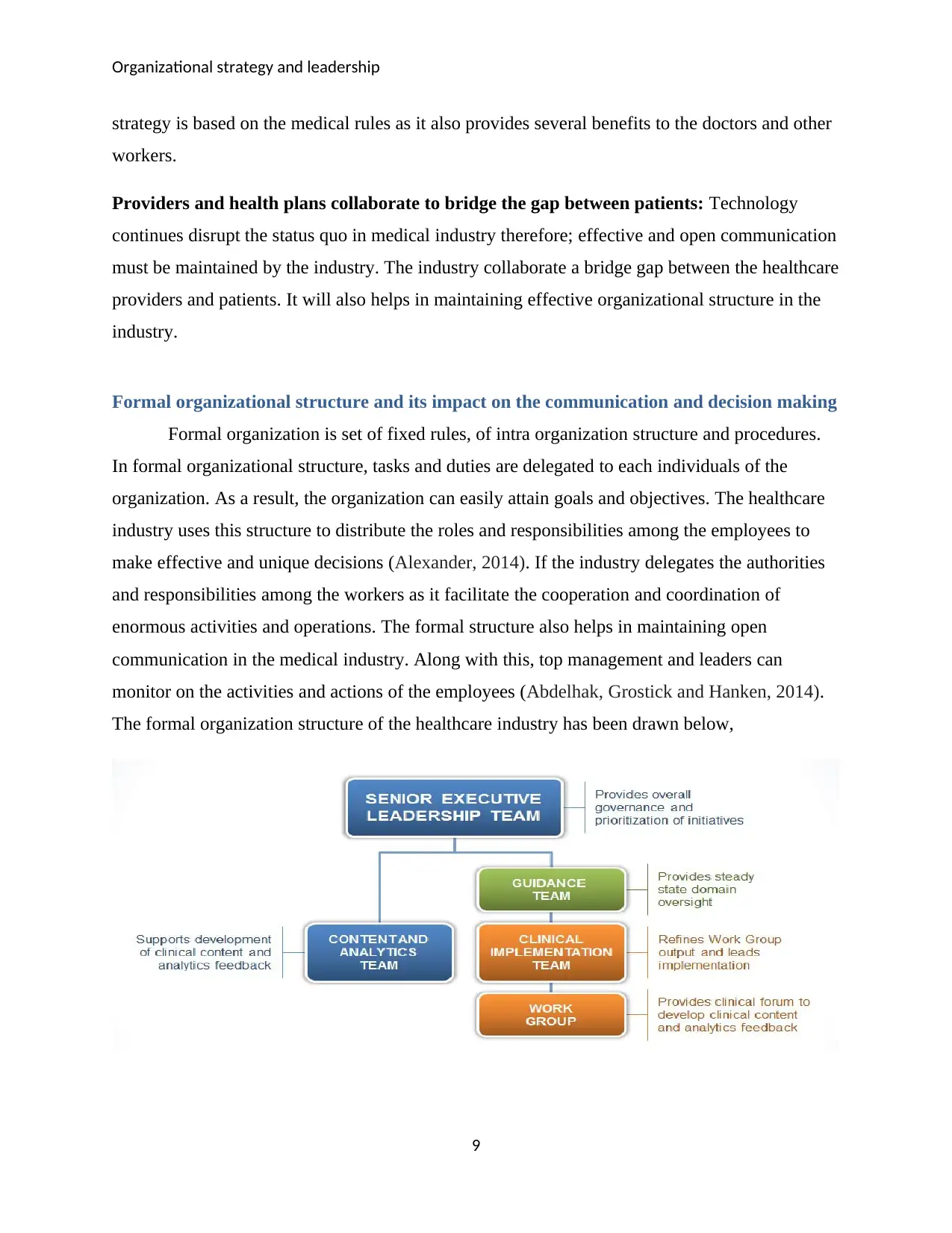
Organizational strategy and leadership
strategy is based on the medical rules as it also provides several benefits to the doctors and other
workers.
Providers and health plans collaborate to bridge the gap between patients: Technology
continues disrupt the status quo in medical industry therefore; effective and open communication
must be maintained by the industry. The industry collaborate a bridge gap between the healthcare
providers and patients. It will also helps in maintaining effective organizational structure in the
industry.
Formal organizational structure and its impact on the communication and decision making
Formal organization is set of fixed rules, of intra organization structure and procedures.
In formal organizational structure, tasks and duties are delegated to each individuals of the
organization. As a result, the organization can easily attain goals and objectives. The healthcare
industry uses this structure to distribute the roles and responsibilities among the employees to
make effective and unique decisions (Alexander, 2014). If the industry delegates the authorities
and responsibilities among the workers as it facilitate the cooperation and coordination of
enormous activities and operations. The formal structure also helps in maintaining open
communication in the medical industry. Along with this, top management and leaders can
monitor on the activities and actions of the employees (Abdelhak, Grostick and Hanken, 2014).
The formal organization structure of the healthcare industry has been drawn below,
9
strategy is based on the medical rules as it also provides several benefits to the doctors and other
workers.
Providers and health plans collaborate to bridge the gap between patients: Technology
continues disrupt the status quo in medical industry therefore; effective and open communication
must be maintained by the industry. The industry collaborate a bridge gap between the healthcare
providers and patients. It will also helps in maintaining effective organizational structure in the
industry.
Formal organizational structure and its impact on the communication and decision making
Formal organization is set of fixed rules, of intra organization structure and procedures.
In formal organizational structure, tasks and duties are delegated to each individuals of the
organization. As a result, the organization can easily attain goals and objectives. The healthcare
industry uses this structure to distribute the roles and responsibilities among the employees to
make effective and unique decisions (Alexander, 2014). If the industry delegates the authorities
and responsibilities among the workers as it facilitate the cooperation and coordination of
enormous activities and operations. The formal structure also helps in maintaining open
communication in the medical industry. Along with this, top management and leaders can
monitor on the activities and actions of the employees (Abdelhak, Grostick and Hanken, 2014).
The formal organization structure of the healthcare industry has been drawn below,
9
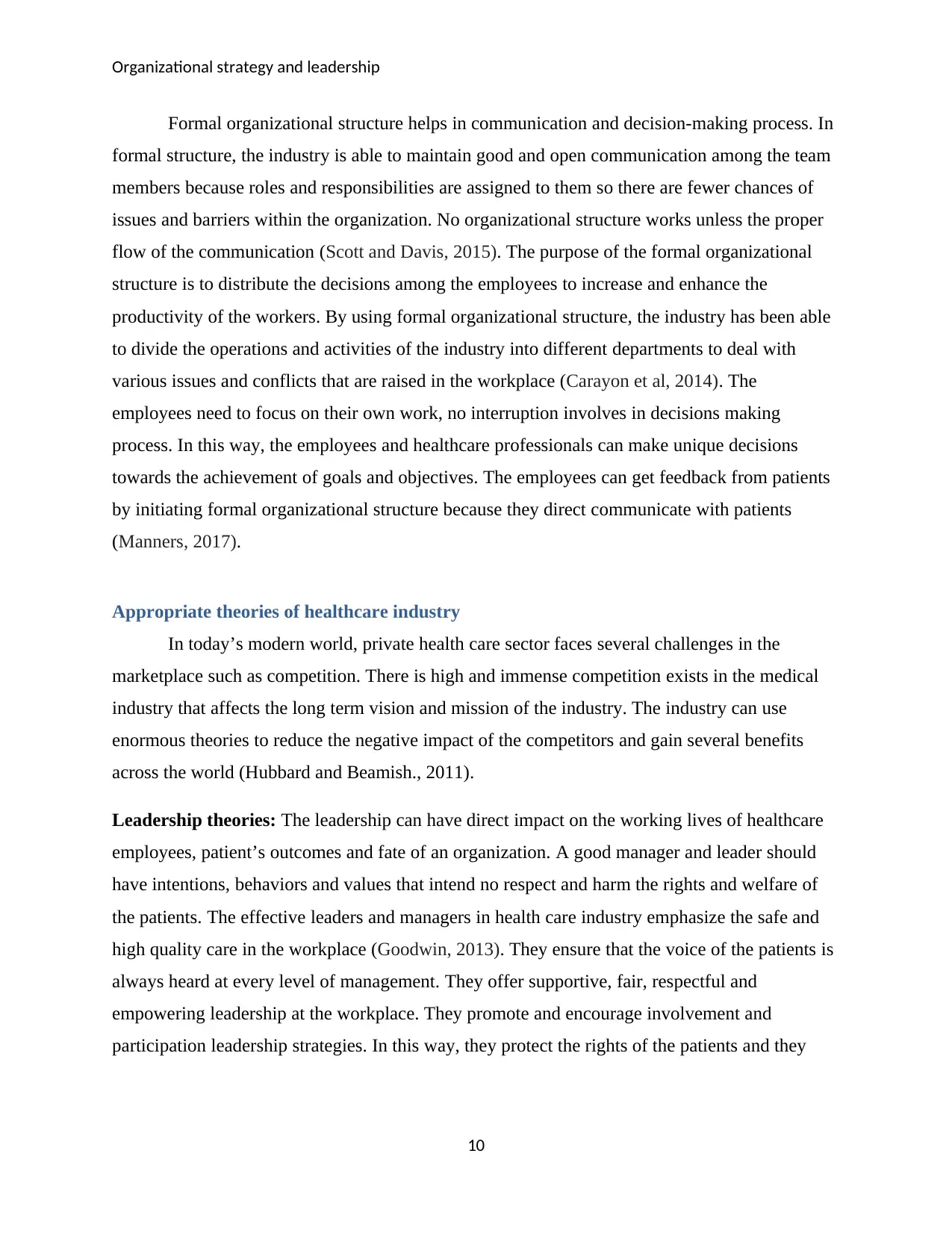
Organizational strategy and leadership
Formal organizational structure helps in communication and decision-making process. In
formal structure, the industry is able to maintain good and open communication among the team
members because roles and responsibilities are assigned to them so there are fewer chances of
issues and barriers within the organization. No organizational structure works unless the proper
flow of the communication (Scott and Davis, 2015). The purpose of the formal organizational
structure is to distribute the decisions among the employees to increase and enhance the
productivity of the workers. By using formal organizational structure, the industry has been able
to divide the operations and activities of the industry into different departments to deal with
various issues and conflicts that are raised in the workplace (Carayon et al, 2014). The
employees need to focus on their own work, no interruption involves in decisions making
process. In this way, the employees and healthcare professionals can make unique decisions
towards the achievement of goals and objectives. The employees can get feedback from patients
by initiating formal organizational structure because they direct communicate with patients
(Manners, 2017).
Appropriate theories of healthcare industry
In today’s modern world, private health care sector faces several challenges in the
marketplace such as competition. There is high and immense competition exists in the medical
industry that affects the long term vision and mission of the industry. The industry can use
enormous theories to reduce the negative impact of the competitors and gain several benefits
across the world (Hubbard and Beamish., 2011).
Leadership theories: The leadership can have direct impact on the working lives of healthcare
employees, patient’s outcomes and fate of an organization. A good manager and leader should
have intentions, behaviors and values that intend no respect and harm the rights and welfare of
the patients. The effective leaders and managers in health care industry emphasize the safe and
high quality care in the workplace (Goodwin, 2013). They ensure that the voice of the patients is
always heard at every level of management. They offer supportive, fair, respectful and
empowering leadership at the workplace. They promote and encourage involvement and
participation leadership strategies. In this way, they protect the rights of the patients and they
10
Formal organizational structure helps in communication and decision-making process. In
formal structure, the industry is able to maintain good and open communication among the team
members because roles and responsibilities are assigned to them so there are fewer chances of
issues and barriers within the organization. No organizational structure works unless the proper
flow of the communication (Scott and Davis, 2015). The purpose of the formal organizational
structure is to distribute the decisions among the employees to increase and enhance the
productivity of the workers. By using formal organizational structure, the industry has been able
to divide the operations and activities of the industry into different departments to deal with
various issues and conflicts that are raised in the workplace (Carayon et al, 2014). The
employees need to focus on their own work, no interruption involves in decisions making
process. In this way, the employees and healthcare professionals can make unique decisions
towards the achievement of goals and objectives. The employees can get feedback from patients
by initiating formal organizational structure because they direct communicate with patients
(Manners, 2017).
Appropriate theories of healthcare industry
In today’s modern world, private health care sector faces several challenges in the
marketplace such as competition. There is high and immense competition exists in the medical
industry that affects the long term vision and mission of the industry. The industry can use
enormous theories to reduce the negative impact of the competitors and gain several benefits
across the world (Hubbard and Beamish., 2011).
Leadership theories: The leadership can have direct impact on the working lives of healthcare
employees, patient’s outcomes and fate of an organization. A good manager and leader should
have intentions, behaviors and values that intend no respect and harm the rights and welfare of
the patients. The effective leaders and managers in health care industry emphasize the safe and
high quality care in the workplace (Goodwin, 2013). They ensure that the voice of the patients is
always heard at every level of management. They offer supportive, fair, respectful and
empowering leadership at the workplace. They promote and encourage involvement and
participation leadership strategies. In this way, they protect the rights of the patients and they
10
Secure Best Marks with AI Grader
Need help grading? Try our AI Grader for instant feedback on your assignments.
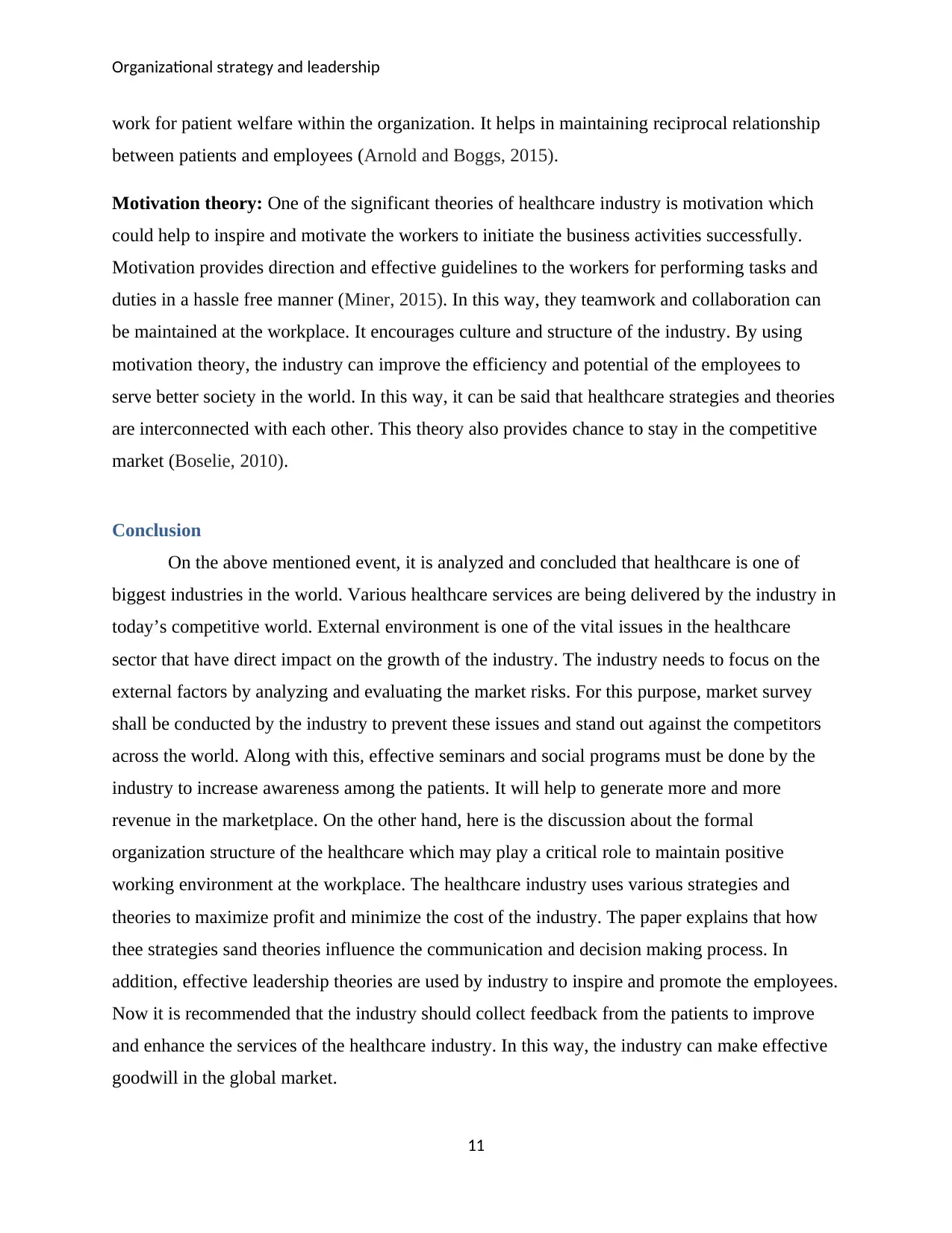
Organizational strategy and leadership
work for patient welfare within the organization. It helps in maintaining reciprocal relationship
between patients and employees (Arnold and Boggs, 2015).
Motivation theory: One of the significant theories of healthcare industry is motivation which
could help to inspire and motivate the workers to initiate the business activities successfully.
Motivation provides direction and effective guidelines to the workers for performing tasks and
duties in a hassle free manner (Miner, 2015). In this way, they teamwork and collaboration can
be maintained at the workplace. It encourages culture and structure of the industry. By using
motivation theory, the industry can improve the efficiency and potential of the employees to
serve better society in the world. In this way, it can be said that healthcare strategies and theories
are interconnected with each other. This theory also provides chance to stay in the competitive
market (Boselie, 2010).
Conclusion
On the above mentioned event, it is analyzed and concluded that healthcare is one of
biggest industries in the world. Various healthcare services are being delivered by the industry in
today’s competitive world. External environment is one of the vital issues in the healthcare
sector that have direct impact on the growth of the industry. The industry needs to focus on the
external factors by analyzing and evaluating the market risks. For this purpose, market survey
shall be conducted by the industry to prevent these issues and stand out against the competitors
across the world. Along with this, effective seminars and social programs must be done by the
industry to increase awareness among the patients. It will help to generate more and more
revenue in the marketplace. On the other hand, here is the discussion about the formal
organization structure of the healthcare which may play a critical role to maintain positive
working environment at the workplace. The healthcare industry uses various strategies and
theories to maximize profit and minimize the cost of the industry. The paper explains that how
thee strategies sand theories influence the communication and decision making process. In
addition, effective leadership theories are used by industry to inspire and promote the employees.
Now it is recommended that the industry should collect feedback from the patients to improve
and enhance the services of the healthcare industry. In this way, the industry can make effective
goodwill in the global market.
11
work for patient welfare within the organization. It helps in maintaining reciprocal relationship
between patients and employees (Arnold and Boggs, 2015).
Motivation theory: One of the significant theories of healthcare industry is motivation which
could help to inspire and motivate the workers to initiate the business activities successfully.
Motivation provides direction and effective guidelines to the workers for performing tasks and
duties in a hassle free manner (Miner, 2015). In this way, they teamwork and collaboration can
be maintained at the workplace. It encourages culture and structure of the industry. By using
motivation theory, the industry can improve the efficiency and potential of the employees to
serve better society in the world. In this way, it can be said that healthcare strategies and theories
are interconnected with each other. This theory also provides chance to stay in the competitive
market (Boselie, 2010).
Conclusion
On the above mentioned event, it is analyzed and concluded that healthcare is one of
biggest industries in the world. Various healthcare services are being delivered by the industry in
today’s competitive world. External environment is one of the vital issues in the healthcare
sector that have direct impact on the growth of the industry. The industry needs to focus on the
external factors by analyzing and evaluating the market risks. For this purpose, market survey
shall be conducted by the industry to prevent these issues and stand out against the competitors
across the world. Along with this, effective seminars and social programs must be done by the
industry to increase awareness among the patients. It will help to generate more and more
revenue in the marketplace. On the other hand, here is the discussion about the formal
organization structure of the healthcare which may play a critical role to maintain positive
working environment at the workplace. The healthcare industry uses various strategies and
theories to maximize profit and minimize the cost of the industry. The paper explains that how
thee strategies sand theories influence the communication and decision making process. In
addition, effective leadership theories are used by industry to inspire and promote the employees.
Now it is recommended that the industry should collect feedback from the patients to improve
and enhance the services of the healthcare industry. In this way, the industry can make effective
goodwill in the global market.
11
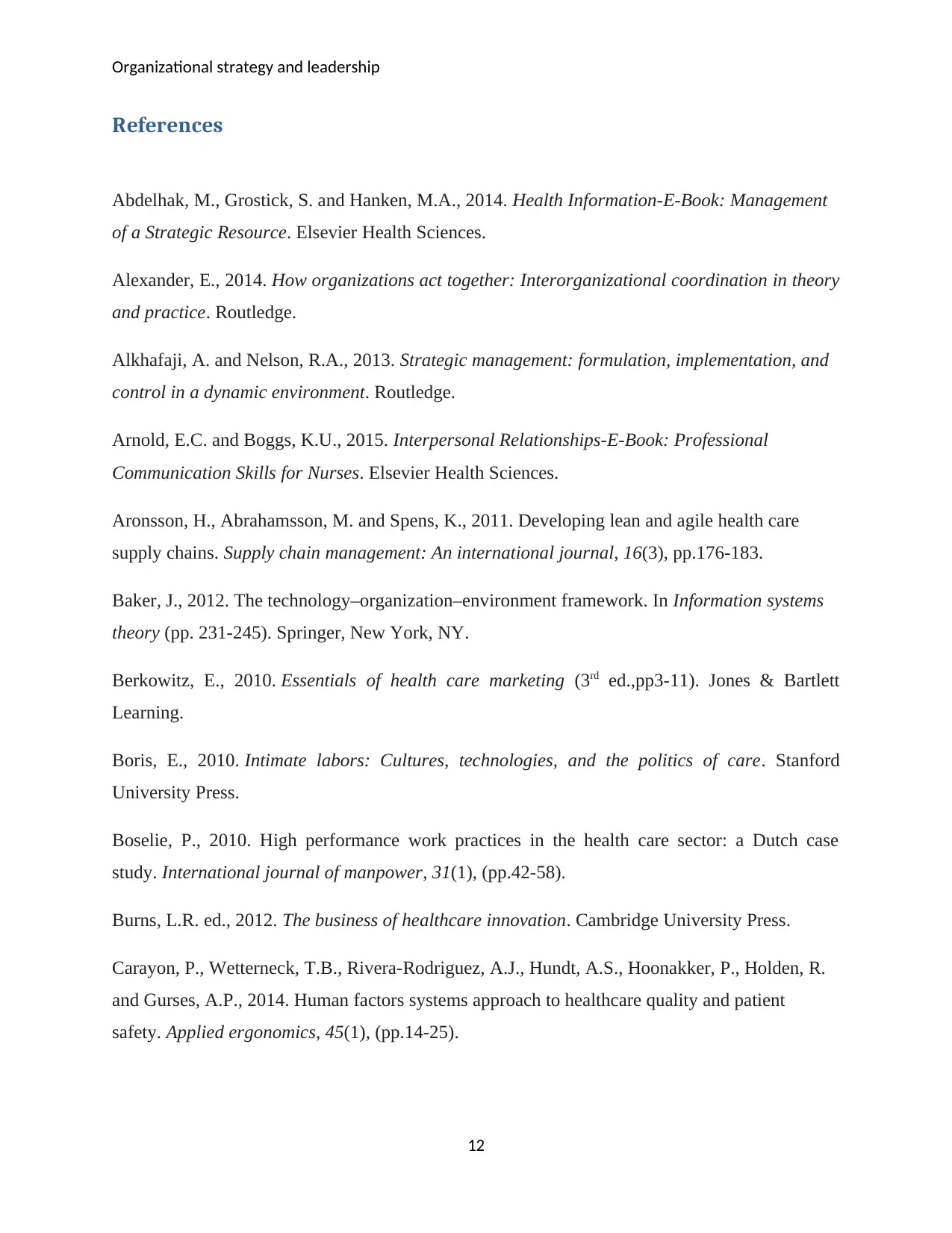
Organizational strategy and leadership
References
Abdelhak, M., Grostick, S. and Hanken, M.A., 2014. Health Information-E-Book: Management
of a Strategic Resource. Elsevier Health Sciences.
Alexander, E., 2014. How organizations act together: Interorganizational coordination in theory
and practice. Routledge.
Alkhafaji, A. and Nelson, R.A., 2013. Strategic management: formulation, implementation, and
control in a dynamic environment. Routledge.
Arnold, E.C. and Boggs, K.U., 2015. Interpersonal Relationships-E-Book: Professional
Communication Skills for Nurses. Elsevier Health Sciences.
Aronsson, H., Abrahamsson, M. and Spens, K., 2011. Developing lean and agile health care
supply chains. Supply chain management: An international journal, 16(3), pp.176-183.
Baker, J., 2012. The technology–organization–environment framework. In Information systems
theory (pp. 231-245). Springer, New York, NY.
Berkowitz, E., 2010. Essentials of health care marketing (3rd ed.,pp3-11). Jones & Bartlett
Learning.
Boris, E., 2010. Intimate labors: Cultures, technologies, and the politics of care. Stanford
University Press.
Boselie, P., 2010. High performance work practices in the health care sector: a Dutch case
study. International journal of manpower, 31(1), (pp.42-58).
Burns, L.R. ed., 2012. The business of healthcare innovation. Cambridge University Press.
Carayon, P., Wetterneck, T.B., Rivera-Rodriguez, A.J., Hundt, A.S., Hoonakker, P., Holden, R.
and Gurses, A.P., 2014. Human factors systems approach to healthcare quality and patient
safety. Applied ergonomics, 45(1), (pp.14-25).
12
References
Abdelhak, M., Grostick, S. and Hanken, M.A., 2014. Health Information-E-Book: Management
of a Strategic Resource. Elsevier Health Sciences.
Alexander, E., 2014. How organizations act together: Interorganizational coordination in theory
and practice. Routledge.
Alkhafaji, A. and Nelson, R.A., 2013. Strategic management: formulation, implementation, and
control in a dynamic environment. Routledge.
Arnold, E.C. and Boggs, K.U., 2015. Interpersonal Relationships-E-Book: Professional
Communication Skills for Nurses. Elsevier Health Sciences.
Aronsson, H., Abrahamsson, M. and Spens, K., 2011. Developing lean and agile health care
supply chains. Supply chain management: An international journal, 16(3), pp.176-183.
Baker, J., 2012. The technology–organization–environment framework. In Information systems
theory (pp. 231-245). Springer, New York, NY.
Berkowitz, E., 2010. Essentials of health care marketing (3rd ed.,pp3-11). Jones & Bartlett
Learning.
Boris, E., 2010. Intimate labors: Cultures, technologies, and the politics of care. Stanford
University Press.
Boselie, P., 2010. High performance work practices in the health care sector: a Dutch case
study. International journal of manpower, 31(1), (pp.42-58).
Burns, L.R. ed., 2012. The business of healthcare innovation. Cambridge University Press.
Carayon, P., Wetterneck, T.B., Rivera-Rodriguez, A.J., Hundt, A.S., Hoonakker, P., Holden, R.
and Gurses, A.P., 2014. Human factors systems approach to healthcare quality and patient
safety. Applied ergonomics, 45(1), (pp.14-25).
12
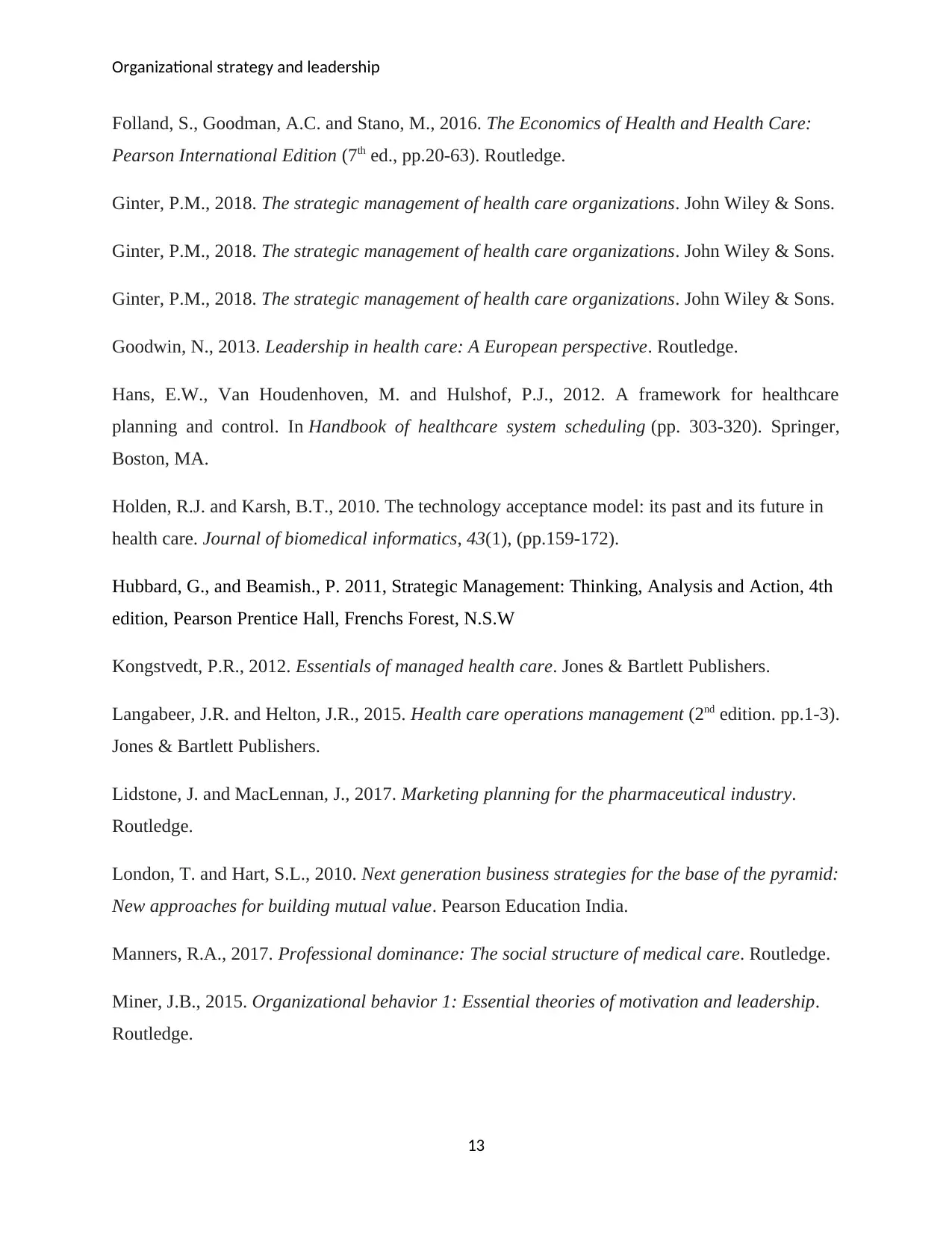
Organizational strategy and leadership
Folland, S., Goodman, A.C. and Stano, M., 2016. The Economics of Health and Health Care:
Pearson International Edition (7th ed., pp.20-63). Routledge.
Ginter, P.M., 2018. The strategic management of health care organizations. John Wiley & Sons.
Ginter, P.M., 2018. The strategic management of health care organizations. John Wiley & Sons.
Ginter, P.M., 2018. The strategic management of health care organizations. John Wiley & Sons.
Goodwin, N., 2013. Leadership in health care: A European perspective. Routledge.
Hans, E.W., Van Houdenhoven, M. and Hulshof, P.J., 2012. A framework for healthcare
planning and control. In Handbook of healthcare system scheduling (pp. 303-320). Springer,
Boston, MA.
Holden, R.J. and Karsh, B.T., 2010. The technology acceptance model: its past and its future in
health care. Journal of biomedical informatics, 43(1), (pp.159-172).
Hubbard, G., and Beamish., P. 2011, Strategic Management: Thinking, Analysis and Action, 4th
edition, Pearson Prentice Hall, Frenchs Forest, N.S.W
Kongstvedt, P.R., 2012. Essentials of managed health care. Jones & Bartlett Publishers.
Langabeer, J.R. and Helton, J.R., 2015. Health care operations management (2nd edition. pp.1-3).
Jones & Bartlett Publishers.
Lidstone, J. and MacLennan, J., 2017. Marketing planning for the pharmaceutical industry.
Routledge.
London, T. and Hart, S.L., 2010. Next generation business strategies for the base of the pyramid:
New approaches for building mutual value. Pearson Education India.
Manners, R.A., 2017. Professional dominance: The social structure of medical care. Routledge.
Miner, J.B., 2015. Organizational behavior 1: Essential theories of motivation and leadership.
Routledge.
13
Folland, S., Goodman, A.C. and Stano, M., 2016. The Economics of Health and Health Care:
Pearson International Edition (7th ed., pp.20-63). Routledge.
Ginter, P.M., 2018. The strategic management of health care organizations. John Wiley & Sons.
Ginter, P.M., 2018. The strategic management of health care organizations. John Wiley & Sons.
Ginter, P.M., 2018. The strategic management of health care organizations. John Wiley & Sons.
Goodwin, N., 2013. Leadership in health care: A European perspective. Routledge.
Hans, E.W., Van Houdenhoven, M. and Hulshof, P.J., 2012. A framework for healthcare
planning and control. In Handbook of healthcare system scheduling (pp. 303-320). Springer,
Boston, MA.
Holden, R.J. and Karsh, B.T., 2010. The technology acceptance model: its past and its future in
health care. Journal of biomedical informatics, 43(1), (pp.159-172).
Hubbard, G., and Beamish., P. 2011, Strategic Management: Thinking, Analysis and Action, 4th
edition, Pearson Prentice Hall, Frenchs Forest, N.S.W
Kongstvedt, P.R., 2012. Essentials of managed health care. Jones & Bartlett Publishers.
Langabeer, J.R. and Helton, J.R., 2015. Health care operations management (2nd edition. pp.1-3).
Jones & Bartlett Publishers.
Lidstone, J. and MacLennan, J., 2017. Marketing planning for the pharmaceutical industry.
Routledge.
London, T. and Hart, S.L., 2010. Next generation business strategies for the base of the pyramid:
New approaches for building mutual value. Pearson Education India.
Manners, R.A., 2017. Professional dominance: The social structure of medical care. Routledge.
Miner, J.B., 2015. Organizational behavior 1: Essential theories of motivation and leadership.
Routledge.
13
Paraphrase This Document
Need a fresh take? Get an instant paraphrase of this document with our AI Paraphraser
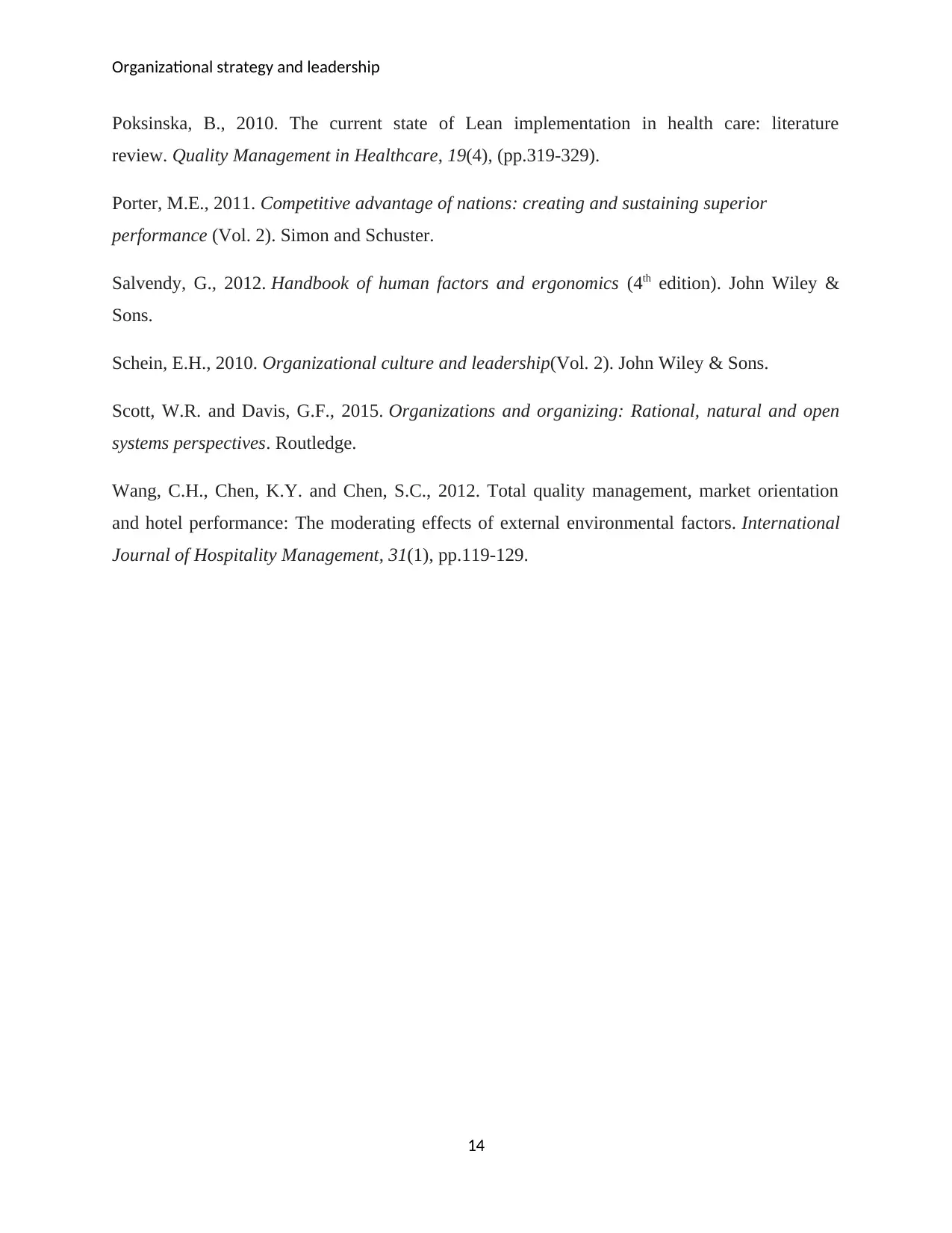
Organizational strategy and leadership
Poksinska, B., 2010. The current state of Lean implementation in health care: literature
review. Quality Management in Healthcare, 19(4), (pp.319-329).
Porter, M.E., 2011. Competitive advantage of nations: creating and sustaining superior
performance (Vol. 2). Simon and Schuster.
Salvendy, G., 2012. Handbook of human factors and ergonomics (4th edition). John Wiley &
Sons.
Schein, E.H., 2010. Organizational culture and leadership(Vol. 2). John Wiley & Sons.
Scott, W.R. and Davis, G.F., 2015. Organizations and organizing: Rational, natural and open
systems perspectives. Routledge.
Wang, C.H., Chen, K.Y. and Chen, S.C., 2012. Total quality management, market orientation
and hotel performance: The moderating effects of external environmental factors. International
Journal of Hospitality Management, 31(1), pp.119-129.
14
Poksinska, B., 2010. The current state of Lean implementation in health care: literature
review. Quality Management in Healthcare, 19(4), (pp.319-329).
Porter, M.E., 2011. Competitive advantage of nations: creating and sustaining superior
performance (Vol. 2). Simon and Schuster.
Salvendy, G., 2012. Handbook of human factors and ergonomics (4th edition). John Wiley &
Sons.
Schein, E.H., 2010. Organizational culture and leadership(Vol. 2). John Wiley & Sons.
Scott, W.R. and Davis, G.F., 2015. Organizations and organizing: Rational, natural and open
systems perspectives. Routledge.
Wang, C.H., Chen, K.Y. and Chen, S.C., 2012. Total quality management, market orientation
and hotel performance: The moderating effects of external environmental factors. International
Journal of Hospitality Management, 31(1), pp.119-129.
14
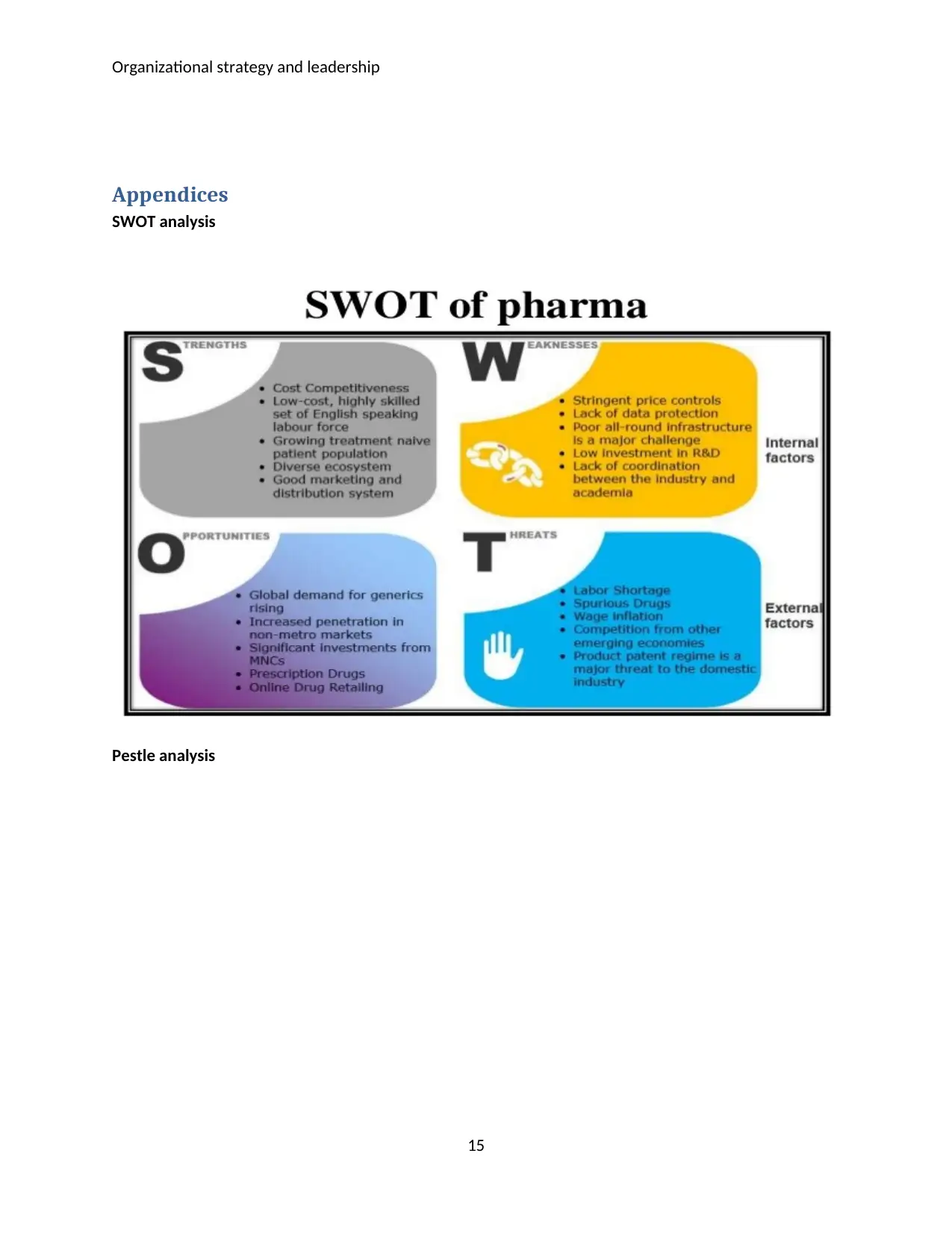
Organizational strategy and leadership
Appendices
SWOT analysis
Pestle analysis
15
Appendices
SWOT analysis
Pestle analysis
15
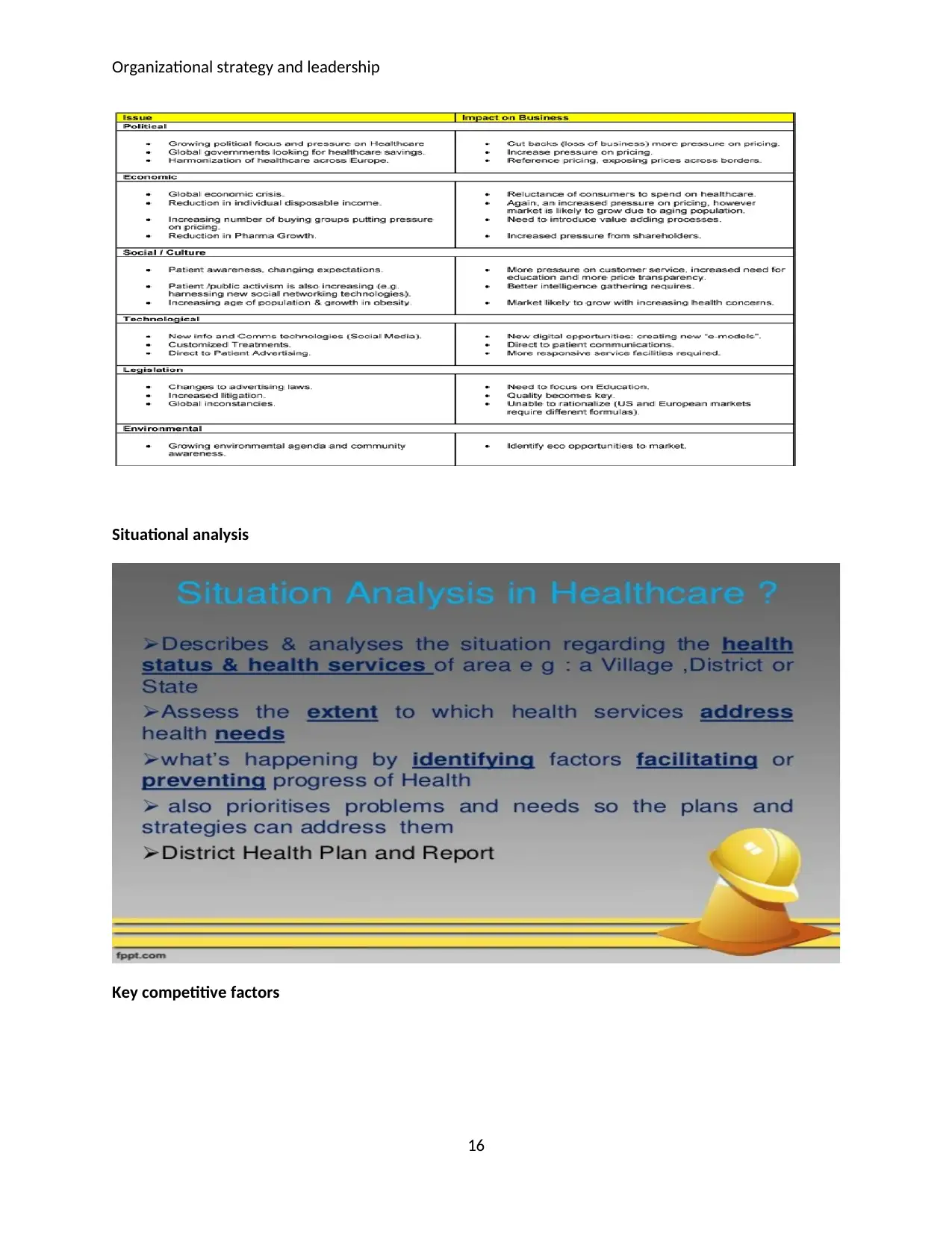
Organizational strategy and leadership
Situational analysis
Key competitive factors
16
Situational analysis
Key competitive factors
16
Secure Best Marks with AI Grader
Need help grading? Try our AI Grader for instant feedback on your assignments.
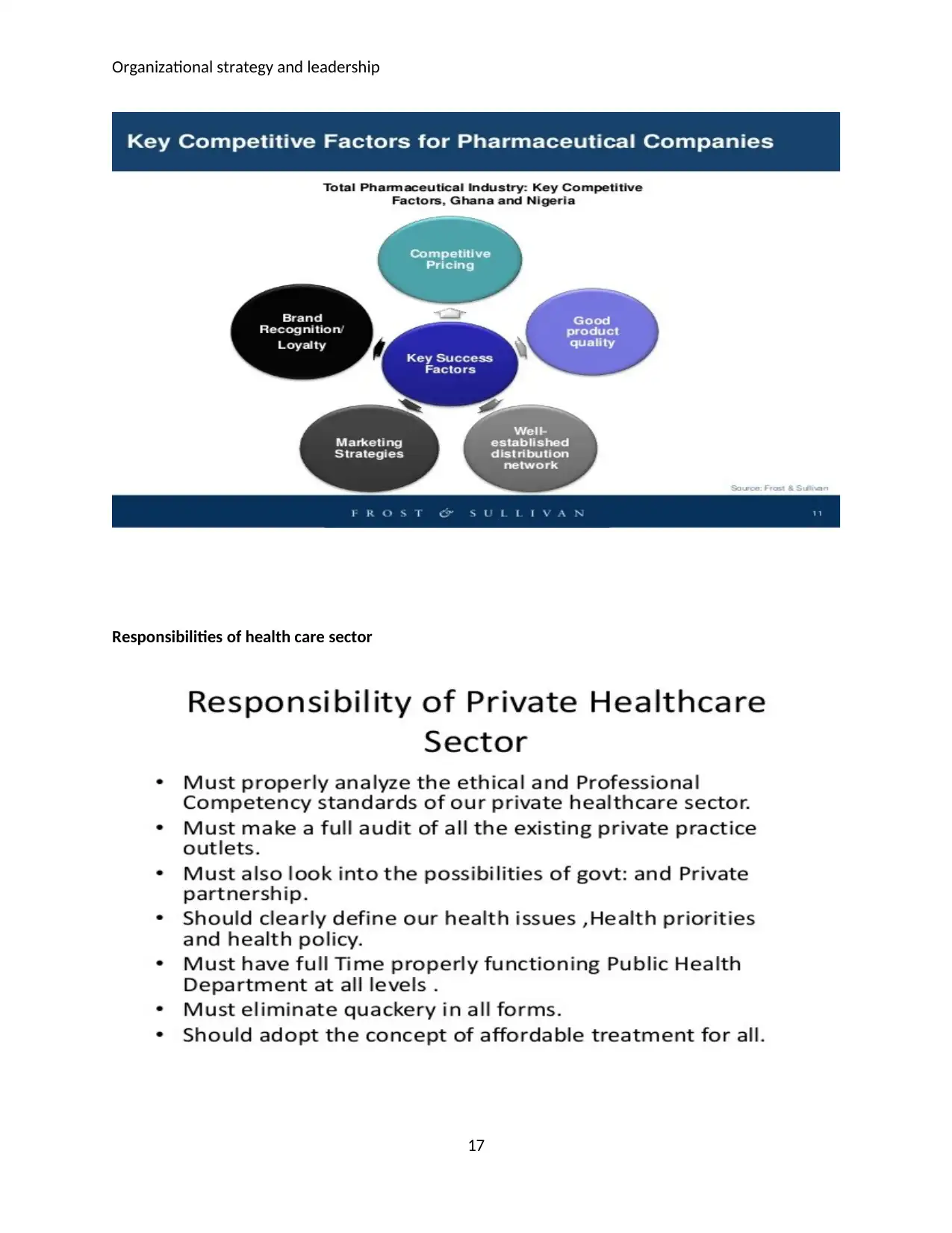
Organizational strategy and leadership
Responsibilities of health care sector
17
Responsibilities of health care sector
17
1 out of 17
Related Documents
Your All-in-One AI-Powered Toolkit for Academic Success.
+13062052269
info@desklib.com
Available 24*7 on WhatsApp / Email
![[object Object]](/_next/static/media/star-bottom.7253800d.svg)
Unlock your academic potential
© 2024 | Zucol Services PVT LTD | All rights reserved.





